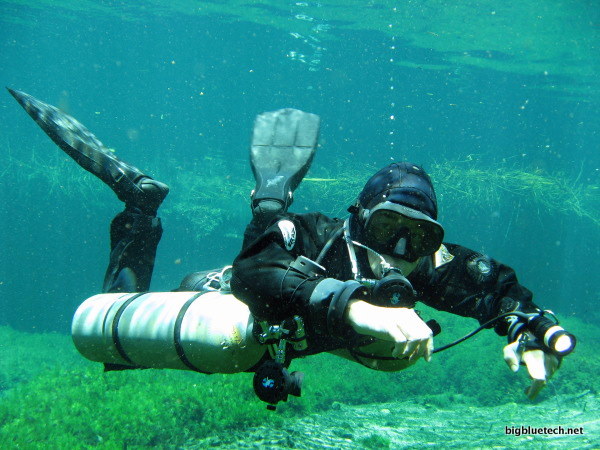
I tried sidemount diving for the first time last year, during a promotion at my local dive shop. Ever since that moment I’ve had my sights set on diving it as much as I can.
It’s without a doubt a bit bulky and uncomfortable on the surface, but as with any dive equipment it’s not designed to be above the water. As soon as you descend you start to feel the perks of it.
Everything is easy to reach, all the hoses are nicely tucked away and you don’t have to deal with the annoyance of having the tank, or tanks, on your back.
Doing a beach dive couldn’t be easier than with sidemount. You set up the tanks, and carry them down in the water where they stay until you’re ready to dive. Once you’ve donned your BC and set up everything you need, you step into the water, rig the tanks to your BC, and start to dive.
No more carrying heavy tanks on your back to the dive site.
Once you descend, it’s pretty much impossible to have a bad trim. You end up horizontal right away, and the BC in combination with the weight of the tanks makes it easy to keep your trim.
To fully understand how sidemount diving got to where it is today, you need to know some of it’s backstory.
Sidemount diving first started in the 60’s, when cave explorers needed to push through flooded or partially flooded passages, but didn’t want to carry around a complete set of diving gear.
They started to bring a tank and a regulator that they easily could push in front of them in tight passages. During the 70’ this evolved and American cave divers started using it. Because the equipment wasn’t available to buy, they started building their own rigs to suit their needs.
During the last three years, sidemount diving has exploded into something that the majority of all training organisations teach, and more and more manufacturers start building their own rigs to release. It’s still mainly popular amongst cave divers, but even technical divers have started to adapt the system to fit their needs.
There are many advantages to diving sidemount.
One of the biggest is that you shift your weight from your back to the sides of your body. This eliminates the pressure and strain on your back and gives you more flexibility. You can enjoy your dives even more. It’s also easier to reach the valves in case of a freeflow, something technical divers need to be able to do.
But the biggest advantage is your air consumption. Diving with two tanks makes it less likely you’ll run out of air before you’re ready to end the dive.
Another advantage is that you become streamlined in a whole new way. It’s suitable for cave diving and wreck diving, where you don’t want to have hoses or anything that can get snagged or entangled.
Sharing air with your buddy is as easy as grabbing your longhose. Technical divers already use this method, and it’s a lot easier than trying to share the same space with your buddy when sharing air from a “regular” hose.
I’m convinced that sidemount is gonna have an ever bigger impact on the diving community than it’s already had, primarily because how easy it is to use.
Manufacturers constantly work on new solutions to simplify, and more and more equipment start to get adapted for use either for regular diving or sidemount.
I fell in love with sidemount because of how easy it was to dive with. Once you descend you feel complete freedom. Or, at least as much freedom as you can get with two cylinders dangling at your sides. That feeling of awe and excitement I got when I first tried diving, many years ago, came back to me again when I tried sidemount. It’s given me a whole new view on diving, and it’s a view I want to see more of.
If you ever get the chance to try sidemount diving, I say go for it. It’s without a doubt an experience you’ll never forget.






